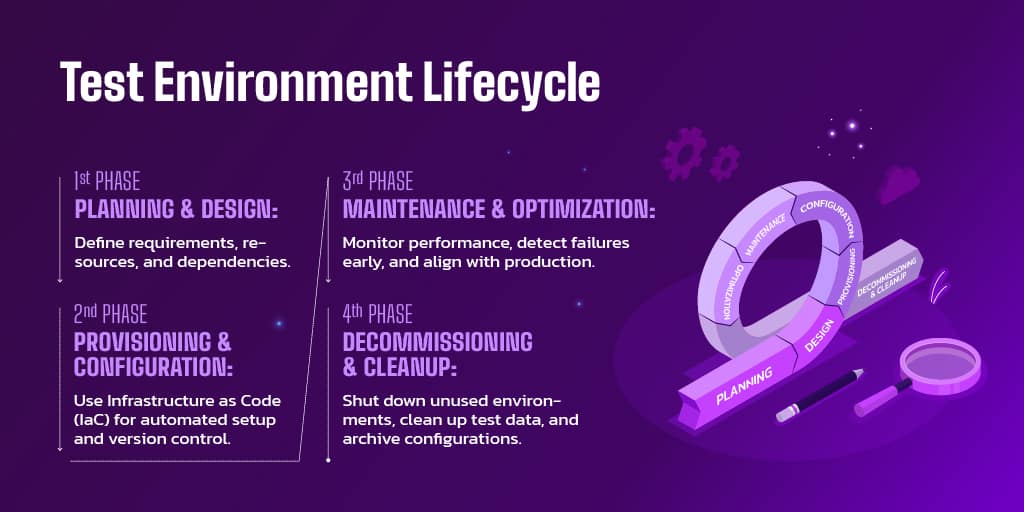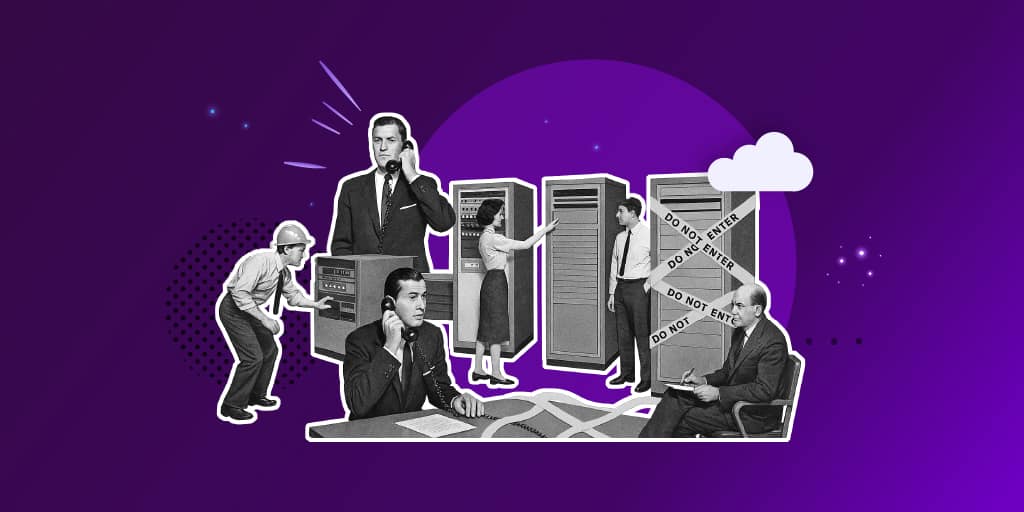Key Highlights
- Discover how to enhance Test Environment Management Lifecycle
- Understand planning challenges and solutions in test environment lifecycle setups
- Explore how maintenance issues impact system reliability
- Learn about security risks and their mitigation during environment decommissioning
In "Test Environment Set Up and Management: The Essential Guide", we explain how a well-managed test environment lifecycle helps teams deliver better software. When properly managed, these environments prevent delays in development, reduce resource waste, and ensure testing effectiveness through proper organization and monitoring.
With this clear distinction, when focusing on the Test Environment Management Lifecycle, we find that each phase presents unique challenges that, if not properly addressed, can compromise software quality and development efficiency. This article examines each Test Environment Management phase in detail, exploring potential problems from poor management, their impact on project success, and practical solutions to address these issues.

Test Environment Management Lifecycle
Test Environment Management Lifecycle
1. Planning & Design Phase
Here's the thing, almost half of test environment headaches come from not planning things out properly. We've spotted three big issues that can mess things up down the line: messy requirements all over the place, getting the resource numbers wrong, and people not staying in the loop. When these problems pop up, they tend to snowball throughout the whole testing process.
Requirement Management Issues:
Implement standardized requirement templates and checklists
- Schedule regular requirement review sessions
- Deploy tracking tools for better organization
Resource Estimation Challenges:
Inaccurate resource estimates can delay testing and increase costs. The solution involves:
- Learning from historical project data
- Building flexibility into resource planning
- Implementing continuous monitoring and adjustment
Stakeholder Engagement:
When stakeholder involvement is lacking, communication needs to be revised. Here's how to maintain engagement:
- Schedule regular stakeholder meetings
- Develop a structured communication plan
- Document and track stakeholder feedback
Addressing these challenges early in the planning phase will help your teams easily move into the provisioning phase, where implementation plays a major role.
2. Provisioning & Configuration Phase
Manual configuration errors and inconsistent setups during these phases significantly impact deployment success and production stability. Let's examine the challenges that can affect your test environment:
Configuration Management:
Inconsistent configurations and poor setup lead to unstable environments and production issues. To address this:
- Implement Infrastructure as Code (IaC)
- Use configuration management tools
- Create automated validation scripts
Process Automation:
Manual processes are error-prone and time-consuming. Beyond CI/CD, other actions may improve efficiency:
- Implement version control for configurations
- Create standardized provisioning templates
- Establish automated testing procedures
Access & Security:
Improper access management creates security vulnerabilities. To keep aligned with LGPD and GDPR, these actions will helṕ:
- Implement role-based access control
- Use secure secrets management
- Conduct regular security audits
Test Data & Dependencies:
Poor data and dependency management lead to unreliable results. To ensure quality:
- Implement automated test data generation
- Maintain comprehensive dependency documentation
- Regular validation of test data quality
With these challenges properly addressed, your team can confidently move forward to the validation phase, where testing ensures environment reliability.
3. Maintenance & Optimization Phase
System maintenance and monitoring directly impact environment stability. More than 50% of problems go unnoticed until they escalate into major issues. When teams only fix things after they break, system downtime grows by 25%. Your team needs to tackle these challenges:
Monitoring & Metrics:
Missing metrics lead to blind spots. To avoid blindness:
- Define and track key performance indicators
- Set up comprehensive metrics collection
- Implement automated alerting systems with meaningful thresholds
Log & Alert Management:
Poor logging and alerting delay problem resolution. To be more proactive than reactive:
- Implement structured logging standards with centralized management
- Establish clear escalation paths
- Regular log analysis and cleanup
Backup & Recovery:
Untested backups risk data loss. Here's how to maintain safety:
- Regular backup testing and validation
- Document and test recovery procedures
- Conduct periodic recovery drills
Proper maintenance and monitoring ensure system stability and enable you to transition to decommissioning when needed.
4. Decommissioning & Clean-up Phase
The final phase of decommissioning presents serious security risks if not handled properly, with data showing that one in five security vulnerabilities stems from incorrect environment shutdown. Let's deep dive into challenges that pose significant risks:
Process Management:
A lack of formal processes increases the risk of oversight. Solutions go by:
- Create standardized decommissioning checklists
- Implement approval workflows
- Document procedures thoroughly
Data Security:
Improper data handling can expose sensitive information. To mitigate these risks:
- Use secure data wiping tools
- Implement verification procedures
- Maintain deletion audit logs
Resource Cleanup:
Incomplete cleanup wastes resources. Here's how to maintain efficiency:
- Automate resource cleanup
- Regular utilization audits
- Implement resource tagging
Proper decommissioning completes the lifecycle, enabling you to start fresh with new environments as needed.
Conclusion
When test environment management is done properly, problems are prevented and software development works perfectly. You need to track and fix issues at each stage to reduce risks, optimize resource usage, and build a reliable testing system. This methodical approach ensures you deliver better quality software more efficiently.
Key Takeaways
- Implement standardized requirement templates and checklists to manage scattered and unclear requirements during the planning phase.
- Use Infrastructure as Code (IaC) for consistent configurations and stable environments in the provisioning phase.
- Define and track KPIs to ensure comprehensive monitoring and metrics during the maintenance phase.
- Regular backup testing and validation to prevent data loss and ensure recovery readiness.
- Use secure data wiping tools and maintain deletion audit logs to mitigate data security risks during decommissioning.


